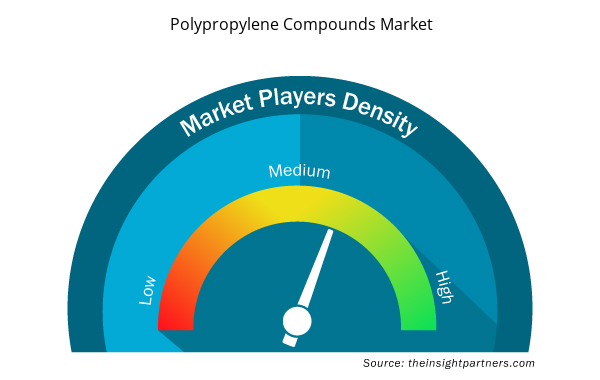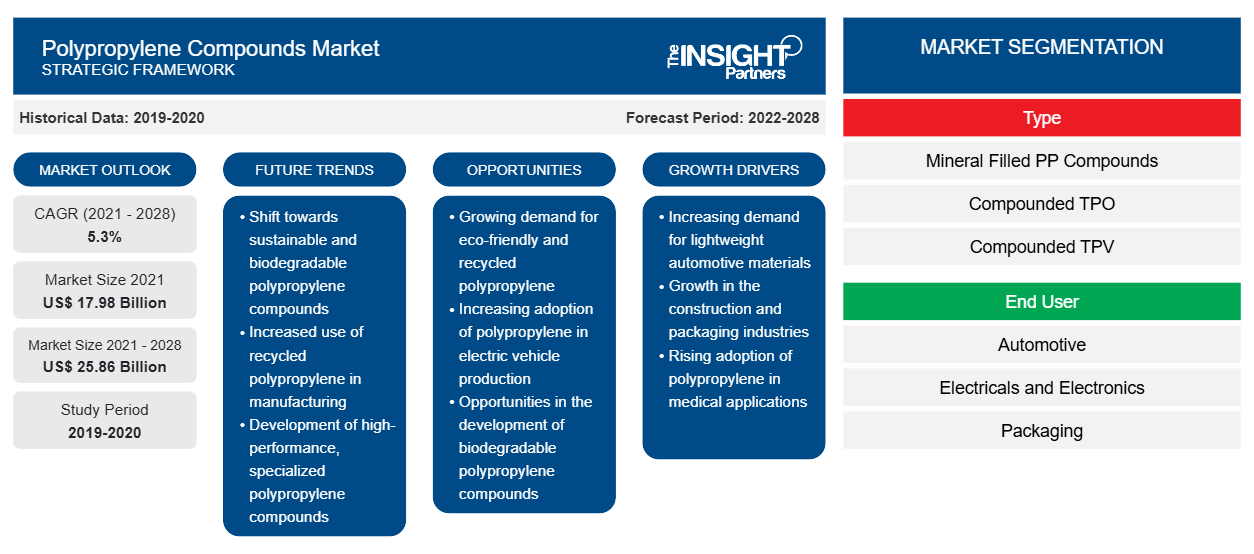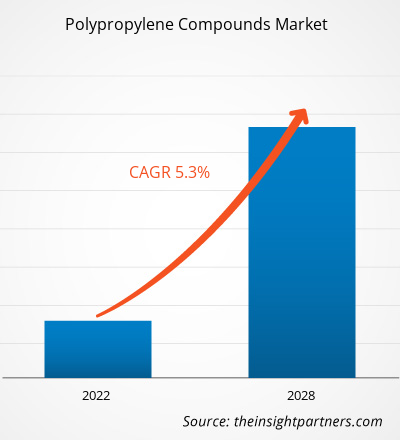[Forschungsbericht] Der Markt für Polypropylenverbindungen soll von 17.977,40 Millionen US-Dollar im Jahr 2021 auf 25.864,00 Millionen US-Dollar im Jahr 2028 anwachsen; von 2021 bis 2028 wird mit einer durchschnittlichen jährlichen Wachstumsrate von 5,3 % gerechnet.
Polypropylen, ein thermoplastisches Polymer, wird in einer Vielzahl von Anwendungen eingesetzt. Es wird grundsätzlich durch Kettenwachstumspolymerisation aus dem Monomer Propylen hergestellt. Polypropylenverbindungen sind grundsätzlich thermoplastische Harze, die aus einer Mischung einer oder mehrerer Polyolefine zusammen mit verschiedenen Komponenten wie Verstärkern, Füllstoffen, Schlagzähmodifikatoren, Additiven und Pigmenten hergestellt werden. Diese Verbindungen bieten viele Eigenschaften und werden in einer Vielzahl von Anwendungen eingesetzt.
Im Jahr 2020 hatte der asiatisch-pazifische Raum den größten Umsatzanteil am Markt für Polypropylenverbindungen . Die Region Asien-Pazifik bietet erhebliche Wachstumschancen für den Markt für Polypropylenverbindungen. China leistet einen großen Beitrag zum Markt in dieser Region. Im Automobilsektor werden zunehmend Polypropylenverbindungen verwendet. Darüber hinaus wächst die Verpackungsindustrie im asiatisch-pazifischen Raum rasant; sie ist zu einem wichtigen Teil der Fertigungsindustrie in der Region geworden. Das Wachstum des Marktes für Polypropylenverbindungen im asiatisch-pazifischen Raum ist in erster Linie auf die Expansion der Bau-, Automobil-, Elektro- und Elektronikindustrie in Ländern wie China, Indien und Südkorea zurückzuführen. Darüber hinaus bauen die auf dem Markt für Polypropylenverbindungen in der Region tätigen Akteure ihre Produktionskapazitäten weiter aus und entwickeln Hochleistungs-Polypropylenverbindungen, um den Markt besser bedienen zu können.
Passen Sie diesen Bericht Ihren Anforderungen an
Sie erhalten kostenlos individuelle Anpassungen an jedem Bericht, einschließlich Teilen dieses Berichts oder einer Analyse auf Länderebene, eines Excel-Datenpakets sowie tolle Angebote und Rabatte für Start-ups und Universitäten.
- Holen Sie sich die wichtigsten Markttrends aus diesem Bericht.Dieses KOSTENLOSE Beispiel umfasst eine Datenanalyse von Markttrends bis hin zu Schätzungen und Prognosen.
Auswirkungen der COVID-19-Pandemie auf den Markt für Polypropylenverbindungen
Die COVID-19-Pandemie hat sich negativ auf die Kunststoffindustrie und die damit verbundenen Märkte ausgewirkt. Die Umsetzung von Maßnahmen zur Bekämpfung der Ausbreitung von SARS-CoV-2 hat das Wachstum mehrerer Industriezweige beeinträchtigt. Branchen wie die Automobil- und Elektronikindustrie sind von den plötzlichen Störungen der Betriebseffizienz und der Wertschöpfungsketten aufgrund der Abriegelung nationaler und internationaler Grenzen betroffen. Die Volkswirtschaften bemühen sich jedoch, ihre Betriebe wieder anzukurbeln. Die Lebensmittelverpackungsindustrie erzeugt eine erhebliche Nachfrage nach Polypropylenverbindungen, da die Verbraucher dazu neigen, Lebensmittel online zu bestellen. Darüber hinaus können die zuvor verschobenen Bauprojekte wieder aufgenommen werden, was weitere Wachstumschancen für die Akteure auf dem Markt für Polypropylenverbindungen bietet. Die auf dem Markt tätigen Unternehmen erholen sich aufgrund der Lösung der Lieferengpässe. Die steigende Nachfrage nach Polypropylenverbindungen in Branchen wie Verpackung, Automobil, Bauwesen, Elektrik und Elektronik wird voraussichtlich das Wachstum des Marktes für Polypropylenverbindungen in den kommenden Jahren vorantreiben.
Markteinblicke
Steigende Nachfrage aus den Bereichen Bauwesen, Textil, Elektrotechnik und Elektronik sowie Automobilbau treibt Wachstum auf dem Markt für Polypropylenverbindungen voran
Der Markt für Polypropylenverbindungen wird hauptsächlich durch die steigende Nachfrage nach diesen Produkten aus der Bau- und Textilindustrie, der Elektro- und Elektronikindustrie sowie der Automobilindustrie angetrieben. In der Automobilindustrie wird Polypropylen häufig als Alternative zu technischen Kunststoffen und Metallen verwendet. Hohe Festigkeit, Steifigkeit und Reinheit machen diese Verbindungen zu einer idealen Option für die Herstellung von Rohrleitungssystemen. Zu den Anwendungen von Polypropylen in der Bauindustrie gehören Verkleidungen, Luft- und Feuchtigkeitsbarrieremembranen, Teppichtextilien, Gebäudeisolationsfolien und -platten, Industrieklebstoffe und -bänder sowie Kunststoffteile.
Materialeinblicke
Der Markt für Polypropylenverbindungen ist nach Typ in mineralgefüllte PP-Verbindungen, zusammengesetztes TPO, zusammengesetztes TPV, glasfaserverstärktes und andere unterteilt. Das Segment der mineralgefüllten PP-Verbindungen hatte im Jahr 2020 den größten Marktanteil. Calciumcarbonat, Talk und Glimmer, die unter anderem mineralgefüllten PP-Verbindungen zugesetzt werden, bieten bei Preissensibilität eine kostengünstige Füllstoffoption. Die mineralgefüllten Verbindungen weisen im Vergleich zu ungefüllten Harzen eine verbesserte Dimensionsstabilität, Steifheit usw. auf. Mineralgefülltes Polypropylen bietet hohe mechanische Steifheit, thermische Stabilität, gute Niedertemperatureigenschaften und gute Dimensionsstabilität über einen weiten Temperaturbereich
Erkenntnisse für Endbenutzer
Basierend auf dem Endverbraucher ist der globale Markt für Polypropylenverbindungen in die Bereiche Automobil, Elektro und Elektronik, Verpackung, Bauwesen, Textilien und Sonstige unterteilt.Das Automobilsegment hatte im Jahr 2020 den größten Anteil am Markt für Polypropylenverbindungen. Da es sich bei Polypropylenverbindungen um ein thermoplastisches Polymer handelt, können sie leicht in nahezu jede Form gebracht werden. Darüber hinaus werden sie als wirtschaftliche Alternative zu teuren Kunststoffen mit ähnlicher Festigkeit und Haltbarkeit verwendet, was die Herstellungskosten weiter senkt.
Zu den wichtigsten Marktteilnehmern auf dem globalen Markt für Polypropylenverbindungen gehören LyondellBasell Industries Holdings BV; Exxon Mobil Corporation; Sumitomo Chemical Co., Ltd; Borealis AG; Rialti SpA; Trinseo; und Total. Die Marktteilnehmer konzentrieren sich stark auf die Entwicklung innovativer und qualitativ hochwertiger Produkte.
Regionale Einblicke in den Markt für Polypropylenverbindungen
Die regionalen Trends und Faktoren, die den Markt für Polypropylenverbindungen im gesamten Prognosezeitraum beeinflussen, wurden von den Analysten von Insight Partners ausführlich erläutert. In diesem Abschnitt werden auch die Marktsegmente und die Geografie von Polypropylenverbindungen in Nordamerika, Europa, im asiatisch-pazifischen Raum, im Nahen Osten und Afrika sowie in Süd- und Mittelamerika erörtert.

- Erhalten Sie regionale Daten zum Markt für Polypropylenverbindungen
Umfang des Marktberichts zu Polypropylenverbindungen
| Berichtsattribut | Details |
|---|---|
| Marktgröße im Jahr 2021 | 17,98 Milliarden US-Dollar |
| Marktgröße bis 2028 | 25,86 Milliarden US-Dollar |
| Globale CAGR (2021 - 2028) | 5,3 % |
| Historische Daten | 2019-2020 |
| Prognosezeitraum | 2022–2028 |
| Abgedeckte Segmente | Nach Typ
|
| Abgedeckte Regionen und Länder | Nordamerika
|
| Marktführer und wichtige Unternehmensprofile |
|
Dichte der Marktteilnehmer für Polypropylenverbindungen: Auswirkungen auf die Geschäftsdynamik verstehen
Der Markt für Polypropylenverbindungen wächst rasant, angetrieben durch die steigende Nachfrage der Endverbraucher aufgrund von Faktoren wie sich entwickelnden Verbraucherpräferenzen, technologischen Fortschritten und einem größeren Bewusstsein für die Vorteile des Produkts. Mit steigender Nachfrage erweitern Unternehmen ihr Angebot, entwickeln Innovationen, um die Bedürfnisse der Verbraucher zu erfüllen, und nutzen neue Trends, was das Marktwachstum weiter ankurbelt.
Die Marktteilnehmerdichte bezieht sich auf die Verteilung von Firmen oder Unternehmen, die in einem bestimmten Markt oder einer bestimmten Branche tätig sind. Sie gibt an, wie viele Wettbewerber (Marktteilnehmer) in einem bestimmten Marktraum im Verhältnis zu seiner Größe oder seinem gesamten Marktwert präsent sind.
Die wichtigsten auf dem Markt für Polypropylenverbindungen tätigen Unternehmen sind:
- LyondellBasell Industries Holdings BV
- Exxon Mobil Corporation
- Sumitomo Chemical Co., Ltd
- Borealis AG
- Rialti SpA
Haftungsausschluss : Die oben aufgeführten Unternehmen sind nicht in einer bestimmten Reihenfolge aufgeführt.

- Überblick über die wichtigsten Akteure auf dem Markt für Polypropylenverbindungen
Bericht-Spotlights
- Fortschrittliche Trends in der Polypropylen-Compounds-Industrie unterstützen Unternehmen bei der Entwicklung wirksamer langfristiger Strategien
- Von den Akteuren auf dem Markt für Polypropylenverbindungen in entwickelten und sich entwickelnden Märkten verfolgte Geschäftswachstumsstrategien
- Quantitative Analyse des Marktes von 2019 bis 2028
- Schätzung der weltweiten Nachfrage nach Polypropylenverbindungen
- Porters Fünf-Kräfte-Analyse zur Veranschaulichung der Wirksamkeit der in der Branche tätigen Käufer und Lieferanten
- Aktuelle Entwicklungen zum Verständnis des Wettbewerbsmarktszenarios
- Trends, Treiber und Hemmnisse für den Markt für Polypropylenverbindungen und Marktaussichten
- Unterstützung im Entscheidungsprozess durch Aufzeigen von Marktstrategien, die das kommerzielle Interesse untermauern und zum Marktwachstum führen
- Die Größe des Marktes für Polypropylenverbindungen an verschiedenen Knotenpunkten
- Detaillierte Übersicht und Segmentierung des Marktes sowie der Dynamik der Polypropylenverbindungen-Industrie
- Größe des Marktes für Polypropylenverbindungen in verschiedenen Regionen mit vielversprechenden Wachstumschancen
Globaler Markt für Polypropylenverbindungen
Nach Typ
- Mineralgefüllte PP-Compounds
- Zusammengesetztes TPO
- Zusammengesetztes TPV
- Glasfaserverstärkt
- Sonstiges
Nach Endbenutzer
- Automobilindustrie
- Elektrik und Elektronik
- Verpackung
- Bauwesen
- Textilien
- Sonstiges
Firmenprofile
- LyondellBasell Industries Holdings BV
- Exxon Mobil Corporation
- Sumitomo Chemical Co., Ltd
- Borealis AG
- Rialti SpA
- Trinseo
- SABIC
- Gesamt
- Historische Analyse (2 Jahre), Basisjahr, Prognose (7 Jahre) mit CAGR
- PEST- und SWOT-Analyse
- Marktgröße Wert/Volumen – Global, Regional, Land
- Branche und Wettbewerbsumfeld
- Excel-Datensatz



Report Coverage
Revenue forecast, Company Analysis, Industry landscape, Growth factors, and Trends

Segment Covered
This text is related
to segments covered.

Regional Scope
North America, Europe, Asia Pacific, Middle East & Africa, South & Central America

Country Scope
This text is related
to country scope.
Häufig gestellte Fragen
Mineral filled PP compounds are one of the widely used types of polypropylene compounds. The mineral filled compounds deliver improvements over unfilled resins, in terms of dimensional stability, stiffness, and others. Mineral-filled polypropylene provides high mechanical stiffness, thermal stability, good low-temperature properties, and good dimensional stability over a wide temperature range. Mineral filled compounds may also be used in high volume, low-cost applications, including appliances, automotive, and packaging.
Asia Pacific region accounted for a significant share of the global polypropylene compounds market in 2020. The market is projected to witness remarkable growth in the near future due to the demand from the automotive manufacturing sector in the region. Moreover, the players operating in the Asia Pacific polypropylene compounds market focuses on expanding production capacities, and research and development of high-performance polypropylene compounds to address rapidly growing needs demand in the region.
Automotive segment accounted for the largest share of the polypropylene compounds market in 2020. Polypropylene compounds is widely used as they can easily be molded into any desired shape. It is also being used as an economical alternative to any expensive plastics of similar strength and durability, which further helps lower the cost of manufacturing.
Glass-reinforced polypropylene is copolymer polypropylene with 20% glass filled. This polypropylene compound has improved dimensional stability, rigidity, warpage resistance, and strength. It can be applied in automotive interior, center consoles, load floors, door modules, and instrument panels. They are also used in underhood automotive applications and is expected to witness considerable growth over the forecast period, owing to the demand from the automotive sector.
The major players operating in the global polypropylene compounds market are are LyondellBasell Industries Holdings B.V.; Exxon Mobil Corporation; SABIC; Sumitomo Chemical Co., Ltd.; Borealis AG; Total; Trinseo; and Rialti S.p.A among many others.
Polypropylene compounds are basically thermoplastic resins that are produced by a mixture of one or more polyolefin base along with various components such as strengtheners, fillers, impact modifiers, additives, and pigments.
Based, on type, the polypropylene compounds market is segmented into mineral filled PP compounds, compounded TPO, compounded TPV, glass reinforced, and others. Based on end-user, automotive, electrical and electronics, packaging, building and construction, textiles, and others.
Trends and growth analysis reports related to Chemicals and Materials : READ MORE..
The List of Companies - Polypropylene Compounds Market
- LyondellBasell Industries Holdings B.V.
- Exxon Mobil Corporation
- Sumitomo Chemical Co., Ltd
- Borealis AG
- Rialti S.p.A.
- Trinseo
- SABIC
- Total
The Insight Partners performs research in 4 major stages: Data Collection & Secondary Research, Primary Research, Data Analysis and Data Triangulation & Final Review.
- Data Collection and Secondary Research:
As a market research and consulting firm operating from a decade, we have published and advised several client across the globe. First step for any study will start with an assessment of currently available data and insights from existing reports. Further, historical and current market information is collected from Investor Presentations, Annual Reports, SEC Filings, etc., and other information related to company’s performance and market positioning are gathered from Paid Databases (Factiva, Hoovers, and Reuters) and various other publications available in public domain.
Several associations trade associates, technical forums, institutes, societies and organization are accessed to gain technical as well as market related insights through their publications such as research papers, blogs and press releases related to the studies are referred to get cues about the market. Further, white papers, journals, magazines, and other news articles published in last 3 years are scrutinized and analyzed to understand the current market trends.
- Primary Research:
The primarily interview analysis comprise of data obtained from industry participants interview and answers to survey questions gathered by in-house primary team.
For primary research, interviews are conducted with industry experts/CEOs/Marketing Managers/VPs/Subject Matter Experts from both demand and supply side to get a 360-degree view of the market. The primary team conducts several interviews based on the complexity of the markets to understand the various market trends and dynamics which makes research more credible and precise.
A typical research interview fulfils the following functions:
- Provides first-hand information on the market size, market trends, growth trends, competitive landscape, and outlook
- Validates and strengthens in-house secondary research findings
- Develops the analysis team’s expertise and market understanding
Primary research involves email interactions and telephone interviews for each market, category, segment, and sub-segment across geographies. The participants who typically take part in such a process include, but are not limited to:
- Industry participants: VPs, business development managers, market intelligence managers and national sales managers
- Outside experts: Valuation experts, research analysts and key opinion leaders specializing in the electronics and semiconductor industry.
Below is the breakup of our primary respondents by company, designation, and region:

Once we receive the confirmation from primary research sources or primary respondents, we finalize the base year market estimation and forecast the data as per the macroeconomic and microeconomic factors assessed during data collection.
- Data Analysis:
Once data is validated through both secondary as well as primary respondents, we finalize the market estimations by hypothesis formulation and factor analysis at regional and country level.
- Macro-Economic Factor Analysis:
We analyse macroeconomic indicators such the gross domestic product (GDP), increase in the demand for goods and services across industries, technological advancement, regional economic growth, governmental policies, the influence of COVID-19, PEST analysis, and other aspects. This analysis aids in setting benchmarks for various nations/regions and approximating market splits. Additionally, the general trend of the aforementioned components aid in determining the market's development possibilities.
- Country Level Data:
Various factors that are especially aligned to the country are taken into account to determine the market size for a certain area and country, including the presence of vendors, such as headquarters and offices, the country's GDP, demand patterns, and industry growth. To comprehend the market dynamics for the nation, a number of growth variables, inhibitors, application areas, and current market trends are researched. The aforementioned elements aid in determining the country's overall market's growth potential.
- Company Profile:
The “Table of Contents” is formulated by listing and analyzing more than 25 - 30 companies operating in the market ecosystem across geographies. However, we profile only 10 companies as a standard practice in our syndicate reports. These 10 companies comprise leading, emerging, and regional players. Nonetheless, our analysis is not restricted to the 10 listed companies, we also analyze other companies present in the market to develop a holistic view and understand the prevailing trends. The “Company Profiles” section in the report covers key facts, business description, products & services, financial information, SWOT analysis, and key developments. The financial information presented is extracted from the annual reports and official documents of the publicly listed companies. Upon collecting the information for the sections of respective companies, we verify them via various primary sources and then compile the data in respective company profiles. The company level information helps us in deriving the base number as well as in forecasting the market size.
- Developing Base Number:
Aggregation of sales statistics (2020-2022) and macro-economic factor, and other secondary and primary research insights are utilized to arrive at base number and related market shares for 2022. The data gaps are identified in this step and relevant market data is analyzed, collected from paid primary interviews or databases. On finalizing the base year market size, forecasts are developed on the basis of macro-economic, industry and market growth factors and company level analysis.
- Data Triangulation and Final Review:
The market findings and base year market size calculations are validated from supply as well as demand side. Demand side validations are based on macro-economic factor analysis and benchmarks for respective regions and countries. In case of supply side validations, revenues of major companies are estimated (in case not available) based on industry benchmark, approximate number of employees, product portfolio, and primary interviews revenues are gathered. Further revenue from target product/service segment is assessed to avoid overshooting of market statistics. In case of heavy deviations between supply and demand side values, all thes steps are repeated to achieve synchronization.
We follow an iterative model, wherein we share our research findings with Subject Matter Experts (SME’s) and Key Opinion Leaders (KOLs) until consensus view of the market is not formulated – this model negates any drastic deviation in the opinions of experts. Only validated and universally acceptable research findings are quoted in our reports.
We have important check points that we use to validate our research findings – which we call – data triangulation, where we validate the information, we generate from secondary sources with primary interviews and then we re-validate with our internal data bases and Subject matter experts. This comprehensive model enables us to deliver high quality, reliable data in shortest possible time.


 Holen Sie sich ein kostenloses Muster für diesen Bericht
Holen Sie sich ein kostenloses Muster für diesen Bericht